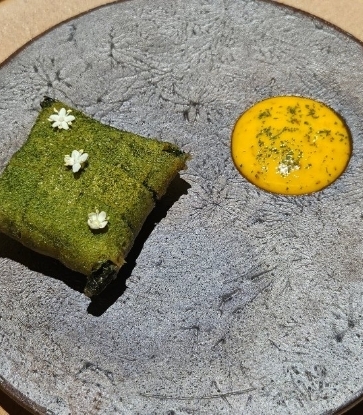Despite the ever-changing global landscape and the whirlwind of globalisation that makes it harder to distinguish between the east and the west, the concept of Lamiat still remains unique on an international level, conveyed through ornate craftsmanship and innovative ideas. As with the perception that extends beyond the mundane concept of ‘food’, the spirit of Lamiat is carried through the Dutch chef, Onno Kokmeijer of restaurant Ciel Bleu (2 stars) in Amsterdam and the figure behind the success of Elements (1 star, MICHELIN Guide Bangkok 2018) at The Okura Prestige Bangkok.
Through the eyes of Onno Kokmeijer, a veteran chef with over 25 years of experience in the culinary world, there are no culinary schools that can teach a person to become a chef. That is because the knowledge of flavours and culinary expertise are something one gains through the perseverance and hours of practice in the kitchen to achieve the most harmonious flavours while maintaining the identity of the chef through the dishes that they wish to present.

This idea is presented through the culinary creations of Elements. Though basked with an air of French cuisine, the flavours are not common of the dishes from the city of perfume, rather, Onno makes use of the culinary techniques and the Lamiat ways of the French traditions by beautifully adapting them into each of his dishes. This is combined with the inspirations taken from the specially-selected quality ingredients from Japan—a practice that remains at the heart of The Okura Prestige, a hotel brand from the land of the rising sun.
Chef Onno chooses to draw from the remarkable philosophies of the Japanese, which include the notion of being respectful to nature and the dedication to preserving the precious ingredients that they have grown and nurtured. There is also the intricate culinary theory ingrained within the Japanese tradition; from the farmers, fishermen and merchants right to the suppliers—each party is scrupulous in the way the ingredients are preserved before it reaches the hand of the chef. In chef Onno’s eyes, these are valuable elements that are remarkable and rare amongst the European practice. It is thus that he chooses to use Japanese produce with the philosophy that he would use the best methods to create the dishes for his customers as a way of paying homage to the people who have dedicated their heart and soul into producing and preserving these ingredients. As such, the arts and science of traditional French cuisine respected by chef Onno and the premium ingredients from Japan are thus combined to create fulfilling and innovative flavours. This is a true experience of aesthetic flavours, the taste of ‘umami’ neatly created and arranged into the plate by the chef for his customers.

To this 45-year-old Dutch chef, the attention to detail is like a ticket to international recognition and the door to becoming one of the world’s leading restaurants.
“The world is changing, particularly the perception of the consumers whose heads are filled with culinary knowledge. They see chefs as ‘rock stars’, and so when the media and the consumer starts to pay more attention in what they are consuming, it means that both the chef and his team at the restaurant have to work even harder and pay even more attention to every detail. That is what emphasises the differences between Michelin-starred restaurants—getting to meet our clientele who has waited for months to come and taste our food, is what brings warmth to our heart.”

The one Michelin-star at Elements is an acknowledgement to chef Onno’s belief that there is always ‘something’ more than taste and flavour, and that certain ‘something’ is the special ‘experience of the aesthetic taste’. “A philosophy that I’ve always believed in what I call ‘guestronomy’. It is providing our clients with a remarkable experience, and that is a Lamiat detail that we pour our hearts into doing.”
The words of chef Onno reflect the overall image of the restaurant whose focus extends beyond the kitchen. “True, we might be using the best ingredients that have been sourced with difficulty and cooked with utmost care, but the customers will never know that if the front-of-house team does not relay these things to them. Hence, it is the role of the front-of-house team that makes them the heart of the dining experience. They are like the messengers for the chef that will convey the stories behind each of the dishes, how the dish is special and why it is cooked that way in order for the clientele to receive the most impressive experience that the chef wishes them to have. Even though the taste of each customer may differ, at the end of the day, the gourmands that have travelled to you are there because they want to taste your food.” This is considered very important, particularly for restaurants at a Michelin-star level, which have to rigorously maintain their standard at all times.
“True, the inspectors from Michelin may come twice a year, but the customers, they come every day. So it is the fine details that you pay attention to that creates a unique identity for the restaurant, and if you can create a remarkable Lamiat experience for them, then that is considered a victory.”

The attention to details of the people in the kitchen may have gone unnoticed, but if one will take time, these intricate elements can immensely add extra charm to the dish that one is tasting. The dedication to ensure that his diners receive a remarkable experience is ‘Lamiat’ through the interpretation of chef Onno Kokmeijer.
No different to Chang’s philosophy of Lamiat where a strong emphasis is placed on the attention to detail, each exquisite dish, prepared with a heart full of respect for the culinary arts, contains a harmony of flavours and freshness. Together, they bring about the ultimate experience of aesthetic taste to both the diner and the culinary world.
This content was brought to you by Chang, Official Partner of the MICHELIN Guide 2018.
www.changbeer.com
www.facebook.com/changbeer/
Here's what our inspectors said about Elements (1 Michelin star)
With impressive city views from its terrace, this restaurant on the 25th floor of the hotel is an ideal spot for a date. Inside, the décor is chic and it's all centred around an open kitchen with oversized industrial light fittings and walls made with charcoal - one of the 'elements'. The modern cuisine creatively fuses the best of French and Japanese dishes, and there is a set menu that offers a varied selection.






















